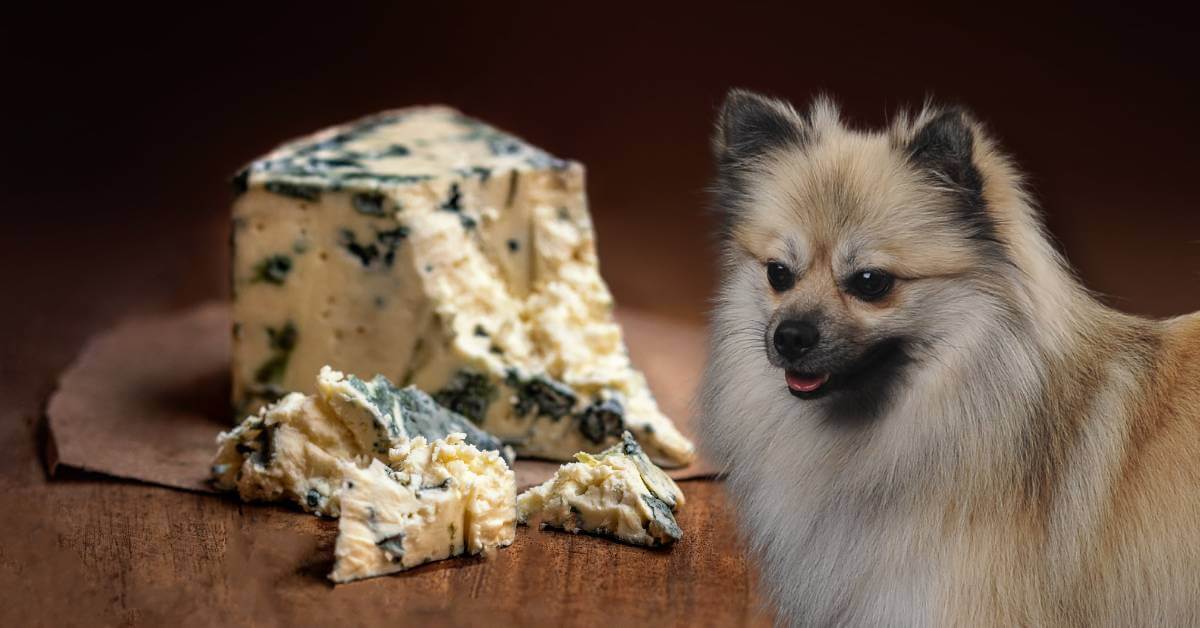Why Blue Cheese is Dangerous for Dogs
Dogs can’t eat blue cheese. The mold in blue cheese produces a substance called roquefortine C, which dogs are particularly sensitive to. This substance can cause symptoms like vomiting, diarrhea, and even seizures in severe cases. So, it’s best to keep blue cheese out of your dog’s diet entirely.

So, what can happen if your dog eats some blue cheese? Well, it really depends on the amount. If we’re talking about a slice of blue cheese, or let’s say, about one teaspoon, they will be fine. A small accidental piece might not cause serious harm, but we want to warn you about giving blue cheese to your dog, as it can be really toxic and quite dangerous for them. So, cheese in general, like Parmesan or Pecorino, is not dangerous for dogs. It’s the specific mold in blue cheese that’s toxic for them.
Why is blue cheese toxic for dogs?
A small amount of blue cheese, like a teaspoon or a slice, usually won’t cause serious harm to your dog. However, larger amounts can be problematic. If your dog consumes more than this, it’s best to keep an eye on them for any unusual symptoms and call your vet if you’re concerned.
Attempts to create non-toxic strains for cheese production haven’t worked out, so roquefortine C is in all blue cheese products. This toxin can cause severe symptoms in dogs, like vomiting, diarrhea, loss of balance, seizures, and even paralysis in extreme cases.
Roquefortine C shows up in different amounts in blue cheese products. For example, blue cheese samples from the US, Canada, and several European countries had this toxin at levels up to 6800 ng/g. Even in American blue cheese salad dressings, roquefortine C was found, though at much lower levels.
There have been incidents of poisoning in animals due to roquefortine C. In one case, cattle developed paralysis after consuming grain heavily infected with Penicillium mold. Similarly, dogs have shown severe symptoms resembling strychnine poisoning after ingesting moldy food containing roquefortine C. These cases highlight how dangerous this toxin can be for dogs, making it important to keep blue cheese and other moldy foods out of their reach.
What to do if your dog eats blue cheese
If your dog eats blue cheese, don’t panic. A small amount, like a teaspoon or a small slice, typically won’t cause serious harm. However, it’s important to take the right steps to ensure your dog’s safety, especially if they ate a larger amount. Here are some steps to follow:
Remember, while small amounts of blue cheese might not be harmful, it’s always better to be cautious and consult your vet for the best course of action.
Symptoms of blue cheese toxicity in dogs
If your dog has consumed blue cheese, keep an eye out for these symptoms, which indicate they might be having a reaction:
If you notice any of these symptoms, get in touch with your local vet to get advice and schedule a visit.
Roquefortine C, the toxin found in blue cheese, can also be present in other moldy foods. This includes moldy bread, spoiled dairy products, and other foods that have gone bad. Because dogs like to scavenge, they might dig through the garbage and eat these moldy foods, putting them at risk of poisoning.
To keep your dog safe, always throw out moldy foods properly and keep them out of reach. Be extra careful with blue cheese and blue cheese crumbles, as they’re easy for dogs to find and tempting to eat. If your dog eats blue cheese, blue cheese crumbles, or any other moldy food, watch for symptoms and call your vet right away.
Love, life, and fur forever!
FAQs
Can a small amount of blue cheese hurt my dog?
A small amount, like a teaspoon or a small slice, usually won’t cause serious harm. However, it’s best to avoid giving blue cheese to your dog due to the potential toxicity.
What should I do if my dog eats blue cheese?
If your dog eats blue cheese, call your vet immediately. Monitor your dog for symptoms like vomiting, diarrhea, loss of coordination, or seizures, and provide fresh water.
Are there other foods that contain roquefortine C?
Yes, roquefortine C can also be found in other moldy foods, like moldy bread and spoiled dairy products. Always dispose of moldy foods properly and keep them out of your dog’s reach.